Alice and John are travelling in their cars to the same destination in same direction. Alice is travelling at the speed of 45 km per hour and has covered 225 kilometers. John covers the same distance by travelling at the speed of 55 km per hour. How long Alice will take to reach the destination than John? (Pre-Algebra)
D is the best option. Time taken by Alice= Distance covered/Speed =225/45 =5 hours Time taken by John =Distance covered/Speed =225/75 =3 hours Additional time Alice will take than John= 5-3 =2 hours A is not true as it reflects time taken by Alice to cover the distance. B is incorrect because it is time taken by John to cover the distance. C is incorrect because it is the combined time taken by Alice AND John. E is incorrect because it does not reflect the difference of the distance covered by Alice and John.
What is the least common multiple of 6 and 7? (pre-algebra)
D is the best option. Multiples of 6= 6,12,18,24,30,36,42,48 Multiples of 7=7,14,21,28,35,42,49,56 The least common multiple is 42. A, B, C and E are incorrect as they are not multiples of both the digits.
Which of the following option is correct about the figure below? (Plane geometry)
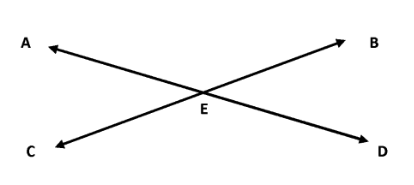
E is the best option. When two lines intersect, the opposite angles are called as vertical angles and are always equal. <AEC and <BED are opposite to each other and are therefore vertical angles. Similarly, <DEC and <BEA are opposite and vertical angles. Hence, both B and C are correct. A is not true as the angles are not vertical. B is incorrect as angles are vertical but besides this option C is also true. The same goes for option C as explained for option B. D is incorrect because angles in option A are not the same.
Triangles DEF and DGH are similar. Line m is parallel to EF. Find the length of DH. (Plane geometry)
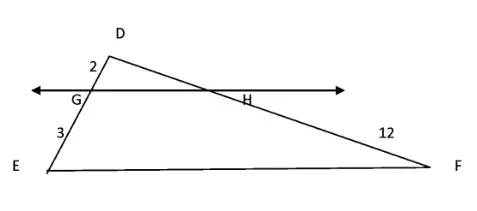
B is the best option. We know that ratio of sides DG:DE IS 2:5 and DH:DF should also be the same. Since HF is equal to 12, so the only possible length of DH is 8. 8:20=4:5 of the side DG:DE. A is incorrect because it is the value of DG. C is incorrect because it is the value of DE. D is the value of HF, so it is incorrect. E is incorrect because it is the value of GE.
The area of the following triangle is 14 cm2. Find its height. (Plane geometry)
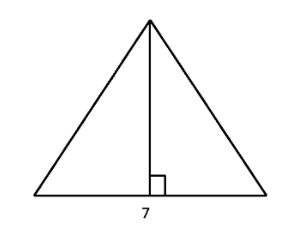
D is the correct option. Area of the triangle= 1⁄2 (height x base) 14 cm2 =1⁄2 (7 x height) 28 cm2 =7b Height = 28/7 =4cm A is not correct as it is the length of its base. B is not true as it is the product of height into base of the triangle. C is incorrect as it does not reflect the base of the triangle. E is incorrect because it is the square of the base of the triangle.
Which of the following is correct about the parallelogram given below? (Plane geometry)
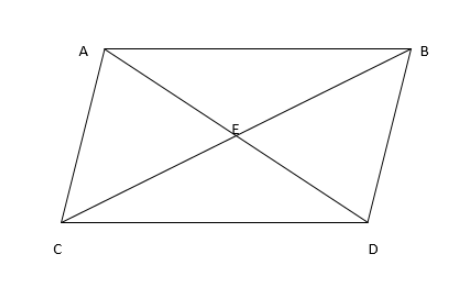
E is the best option. Opposite angles of a parallelogram are equal; therefore, A is true. Similarly, opposite sides are equal and the diagonal bisects a parallelogram, therefore AE =DE and CE = BE Therefore, both A and C are correct. A is correct but besides this option C is also correct. B is incorrect as the sides of the parallelogram and diagonal are not equal. C is correct but besides C, A is also true. D is incorrect because B is incorrect.
Three corners of the square in a standard x-y coordinate plane are (-4,4) , (4,4) and (4,-4). Find the fourth corner. (coordinate geometry)
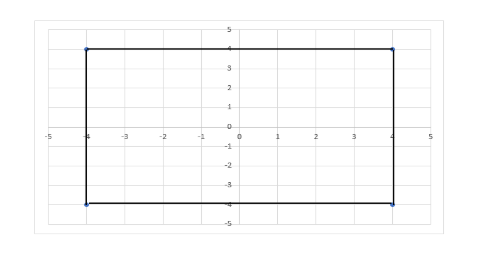
C is the best option. All the sides of a square are equal. We know that (4,4) will be in the first quadrant, (-4,4) will be in the second quadrant, (4,-4) will be in the third quadrant and finally there will be a point in the fourth quadrant which will have both negative coordinates i.e. (-4,-4). You can also draw the points in x-y plane to determine the fourth corner points. A is incorrect because it is the coordinate points of first quadrant. B,D and E cannot be true as they cannot be the fourth corner of the square.
Two points on the line are (2,-3) and (-3,5). Find slope of the line. (coordinate geometry).
A is the best option. Slope = y2-y1/x2-x1 =5-(-3)/-3-2 =-8⁄5 B is incorrect because the slope of these points is not positive. C, D and E are incorrect as putting the values in the formula do not yield these answers.
The graph of the equation y=x2 is given below. What is the graph of the inverse i.e. y=-x2. (Coordinate geometry)
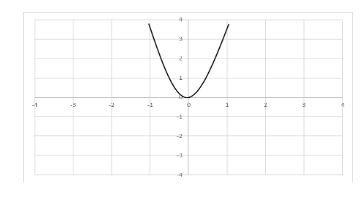
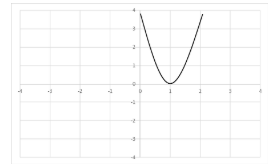
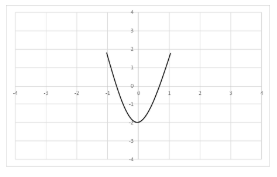
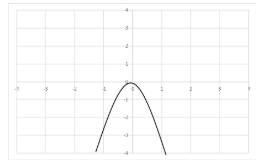
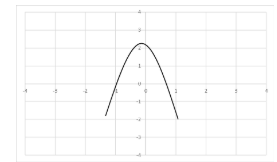
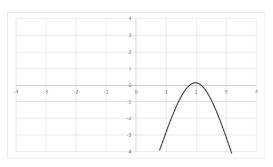
C is the best option. The graph of the equation y=x2 is given. The inverse of the y=x2 is y=-x2, thus the graph will be tilted and the parabola will open downwards like this. A and B are incorrect because the parabola will be open downwards. D and E are incorrect because the shape of the original graph will be the same, only the graph will be shifted downwards.
Find the value of sin F from the right-angle triangle given below. (Trigonometry)
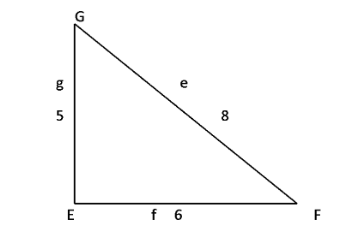
D is the best option. We know that sinθ=perpendicular/hypotenuous =g⁄e =5⁄8 =0.625 A, B, C and E are incorrect as these answers are calculated by using incorrect formula.
If <F=60 °, then, find DE . (Trigonometry)
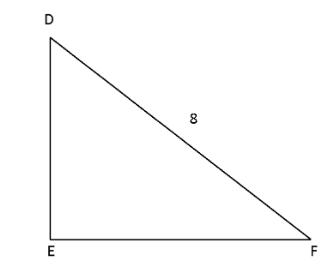
C is the best option. We know that sin θ=perpendicular/hypotenuous Sin θ=DE⁄DF Let DE = x. Put the values in the formula Sin 60O=x⁄8 (0.866) (8) = x x=6.92 Hence, DE = 6.92 A, B, D and E cannot be true as they do not reflect the value of DE when the given information is put in the formula.
The length, width and height of a rectangular box are 8cm, 5cm and 6 cm respectively. Find volume of the box. (Plane geometry).
A is the best option. Volume of the rectangle = length x width x height =8 x 5 x 6 =240 cm3 B, C, D and E are incorrect because these values are calculated using the incorrect formulas for volume of the rectangle.
Find perimeter of the figure given below. (Plane geometry)
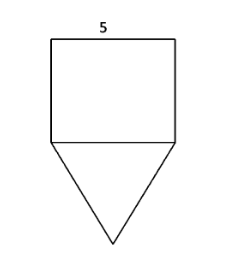
E is the best option. The above figure is a combination of two figures i.e. a square and an equilateral triangle. One side of the square is 5 cm. We know that all sides of the square are of the same length. So, perimeter of the square is 4a. Perimeter of the square = 4(5) =20 One side of the square also forms the base of an inverted triangle. All the sides of an equilateral triangle are equal. Perimeter of a triangle= a+b+c =15 Therefore, the perimeter of the entire figure will be: Perimeter of the square + perimeter of a triangle =20+15 =35 A is incorrect because it is the perimeter of the square only. B is incorrect because it is the perimeter of the triangle only. C is incorrect because perimeters are subtracted while we have to add them to get exact value of the figure. D cannot be true as the combined perimeter of the figure is 35 not 10.
What is graph of the solution set 3x+6>6. (Coordinate geometry)





B is the best option. First divide both sides of the inequality 3x+6>6 by 3. x+6>2 Subtract 6 from both sides. x>-4 Thus, the number line will represent all the values which are greater than -4. We will use an open circle to depict the graph as it indicates that x is greater than but not equal to -4. A is incorrect as it shows x>-3. C is incorrect as it depicts x>-2. D is incorrect as it shows x<3. E is incorrect as it shows x<2.
If cos 2 θ=0.25, then what is tan θ? (Trigonometry)
D is the best option. We are given the value of cos 2 θ=0.25. We know that sin 2 θ+cos 2 θ=1 sin 2 θ=1-0.25 =0.75 sin θ=√0.75 =0.866 cos 2 θ=0.25 cos θ=√0.25 =0.5 Tan θ=sinθ/cosθ =0.8660/.5 =1.73 A is incorrect as it is the value of sin 2 θ. B is incorrect as it is the value of sin sin 2 θ. C is incorrect as sin 2 θ+cos 2 θ=1. E is incorrect as it is the value of cos θ.